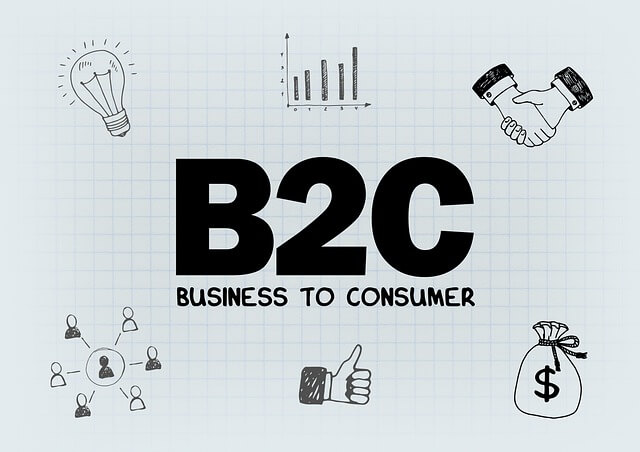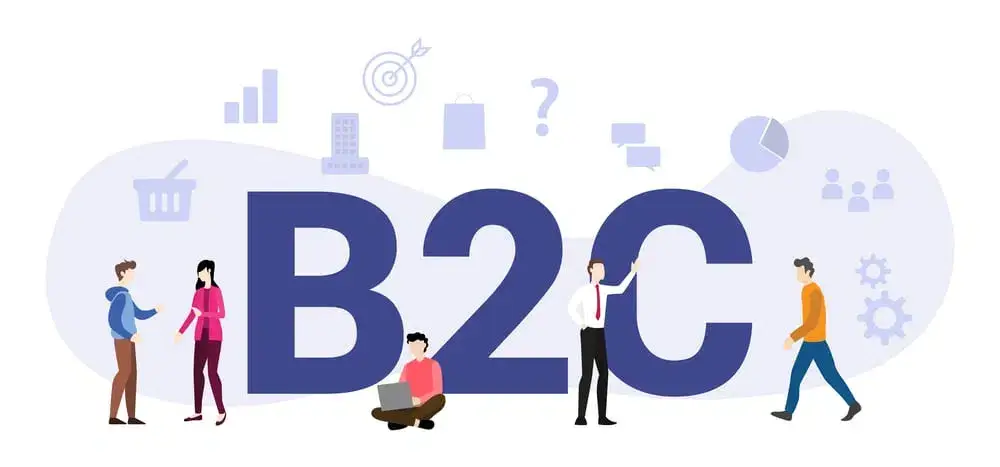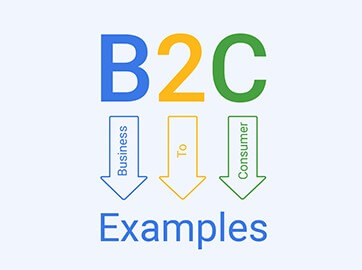Introduction of B2C Marketing
Business-to-consumer (B2C) marketing is a strategy companies use to promote their products or services directly to consumers. The goal of B2C marketing is to increase brand awareness and drive sales. B2C marketing differs from business-to-business (B2B) marketing, which focuses on promoting products or services to other companies.
Importance of B2C Marketing
B2C marketing is essential for several reasons:
- Consumer demand: Consumers drive the economy, and B2C marketing helps companies understand and meet their needs.
- Brand awareness: B2C marketing helps companies increase brand awareness and build consumer relationships.
- Increased sales: B2C marketing can improve sales and revenue by understanding and targeting the right consumers.
- Competitive advantage: Companies that effectively use B2C marketing can gain a competitive advantage over their rivals.
- Long-term success: By building strong consumer relationships, companies can achieve long-term success and stability.
B2C marketing is an essential strategy for any company that wants to succeed in today’s marketplace. Companies can increase brand awareness, drive sales, and achieve long-term success by understanding and targeting the right consumers.
To effectively use a b2c marketing plan, companies must understand the different types of targeting and segmentation, the elements of the marketing mix, and the different types of digital and traditional marketing. They must also measure and analyze the results of their marketing efforts to ensure they are achieving the desired outcome.
In the following sections of this article, we will discuss the different aspects of b2c digital marketing strategy in more detail, including targeting and segmentation, the marketing mix, digital and traditional marketing, and measuring and analyzing.
Targeting and Segmentation
Targeting and segmentation are essential elements of B2C marketing. By understanding and targeting specific groups of consumers, companies can more effectively promote their products or services.
Demographic Segmentation
Demographic segmentation involves dividing the market into groups based on characteristics such as age, gender, income, education, and occupation. For example, a company that sells baby products may target new parents, while a company that sells luxury watches may target high-income individuals.
Psychographic Segmentation
Psychographic segmentation divides the market into groups based on consumers’ lifestyles, values, personalities, and interests. For example, a company that sells outdoor gear may target consumers who are adventurous and enjoy the outdoors. In contrast, a company that sells luxury fashion may target consumers who value status and exclusivity.
Behavioral Segmentation
Behavioral segmentation divides the market into groups based on consumer behavior, such as purchasing habits, brand loyalty, and usage rate. For example, a company that sells coffee may target heavy coffee drinkers, while a company that sells car insurance may target consumers who frequently drive long distances.
Geographic Segmentation
Geographic segmentation involves dividing the market into different geographic regions, such as countries, states, cities, or neighborhoods. For example, a company that sells snowboards may target consumers in mountainous areas, while a company that sells air conditioners may target consumers who live in warm climates.
By using demographic, psychographic, behavioral, and geographic segmentation, companies can better understand and target specific groups of consumers. This can lead to more effective promotion and ultimately increase sales and revenue.
In the following sections of this article, we will discuss the different elements of the marketing mix, digital and traditional marketing, and measuring and analyzing, all are essential aspects of B2C marketing.
Marketing Mix
The marketing mix is a set of tools companies use to promote their products or services. It includes the four Ps: product, price, place, and promotion.
Product
The product refers to the physical product or service that a company offers. In B2C marketing, companies must ensure that their product meets the needs and wants of their target consumers. This includes aspects such as design, quality, packaging, and branding.
Price
The price refers to how much the product or service will cost the consumer. In B2C marketing, companies must ensure that their price is competitive and attractive to their target consumers. This includes aspects such as discounts, financing, and payment options.
Place
Place, also known as distribution, refers to where and how the product or service will be made available to the consumer. In B2C marketing, companies must ensure that their product is available in the right place and at the right time for their target consumers. This includes store location, online sales, and distribution channels.
Promotion
Promotion refers to how a company informs and persuades consumers to buy its product or service. In B2C marketing, companies must ensure that their advertisement is effective and reaches their target consumers. This includes advertising, sales promotions, public relations, and personal selling.
By effectively using the four Ps of the marketing mix, companies can ensure that their product or service meets the needs of their target consumers and is promoted in the right way. This can lead to increased sales and revenue.
In the following sections of this article, we will discuss digital and traditional marketing and measuring and analyzing, which are also essential aspects of B2C marketing.
Digital Marketing
Digital marketing uses channels and technologies to promote products or services to consumers. It has become an increasingly important aspect of B2C marketing in recent years, as more and more consumers use the internet and mobile devices to research and purchase products.
Search Engine Optimization (SEO)
Search Engine Optimization (SEO) involves optimizing a website to rank higher in search engine results pages (SERPs) for relevant keywords. This can increase the website’s visibility and drive more traffic, leading to more sales and revenue.
Paid Search Advertising (PPC)
Paid Search Advertising (PPC) involves paying for ad space on search engine results pages (SERPs) for relevant keywords. This can increase the website’s visibility and drive more traffic, leading to more sales and revenue.
Social Media Marketing
Social Media Marketing involves promoting products or services on social media platforms like Facebook, Instagram, Twitter, and LinkedIn. This can increase brand awareness and drive more website traffic, boosting sales and revenue.
Content Marketing
Content marketing involves creating and distributing valuable content to attract, engage, and convert a target audience into customers. This can include blog posts, articles, videos, infographics, webinars, and more. By providing informative, helpful, and valuable content, companies can build trust and credibility with their target audience and increase the chances of them becoming customers.
Email Marketing
Email marketing involves sending promotional emails to a list of subscribers. This can include newsletters, product updates, and special offers. By sending targeted and personalized emails, companies can increase the chances of their messages being read and acted upon, leading to more sales and revenue.
Influencer Marketing
Influencer Marketing involves partnering with individuals who have a large following on social media platforms and having them promote products or services to their followers. This can increase brand awareness and credibility and drive more sales and revenue.
By effectively using digital marketing techniques, companies can reach and engage their target consumers where they spend most of their time online. This can increase brand awareness, website traffic, and sales and revenue.
In the following sections of this article, we will discuss traditional marketing, measuring, and analyzing, which are also essential aspects of B2C marketing.
Traditional Marketing
Traditional marketing refers to using conventional b2c marketing channels and methods to promote products or services to consumers. While digital marketing has become increasingly important in recent years, traditional marketing still plays a vital role in B2C marketing.
Television Advertising
Television advertising involves creating and airing commercials on television. This can reach a large audience, build brand awareness, and drive sales.
Print Advertising
Print advertising involves placing ads in newspapers, magazines, and other print publications. This can be a cost-effective way to reach a targeted audience and be highly effective in creating brand awareness and driving sales.
Outdoor Advertising
Outdoor advertising involves placing ads on billboards, bus stops, and other outdoor locations. This can be a cost-effective way to reach a large audience, create brand awareness, and drive sales.
Radio Advertising
Radio advertising involves creating and airing commercials on the radio. This can reach a targeted audience, build brand awareness, and drive sales.
Direct Mail
Direct mail involves sending promotional materials, such as brochures and catalogs, directly to consumers through the mail. This can be a highly effective way to reach a targeted audience, create brand awareness, and drive sales.
Event Marketing
Event marketing involves promoting products or services at events, such as trade shows, festivals, and concerts. This can be a highly effective way to reach a targeted audience, create brand awareness, and drive sales.
By effectively using traditional marketing techniques, companies can reach and engage their target consumers in the places where they spend most of their time offline. This can increase brand awareness, website traffic, and sales and revenue.
In the following sections of this article, we will discuss measuring and analyzing, which are also essential aspects of B2C marketing.
Measuring and Analyzing
Measuring and analyzing the effectiveness of B2C marketing efforts is crucial for improving future campaigns and achieving business goals. By gathering and analyzing data, companies can gain insights into how their target audience interacts with their brand and what strategies are working.
Key Performance Indicators (KPIs)
Key Performance Indicators (KPIs) are metrics used to measure a marketing campaign’s success. These include website traffic, conversion rate, cost per acquisition (CPA), and return on investment (ROI). By monitoring these KPIs, companies can gain insights into how their marketing efforts impact business goals.
Google Analytics
Google Analytics is a free web analytics service that provides insights into website traffic and user behavior. This can include metrics such as page views, bounce rate, and user demographics. Using Google Analytics, companies can gain insights into how their target audience interacts with their website and what strategies are working.
Social Media Analytics
Social media analytics tools, such as Facebook Insights and Twitter Analytics, provide insights into engagement and reach on social media platforms. This can include metrics such as likes, shares, and followers. By using social media analytics tools, companies can gain insights into how their target audience interacts with their social media presence and what strategies are working.
A/B Testing
A/B testing tests two marketing campaign versions to see which performs better. This can include testing different headlines, images, or call-to-action (CTA) buttons. By A/B testing, companies can gain insights into the most effective strategies for their target audience.
Surveys and Market Research
Surveys and market research can provide valuable insights into consumer preferences, behavior, and attitudes. This can include metrics such as brand awareness, purchase intent, and Net Promoter Score (NPS). Companies can gain insights into how their target audience perceives their brand and what strategies are working by conducting surveys and market research.
By effectively measuring and analyzing B2C marketing efforts, companies can gain insights into what strategies are working and what areas need improvement. This can help improve future campaigns and achieve business goals.
Conclusion
B2C marketing involves promoting products or services to consumers. It is a crucial aspect of any business that aims to increase brand awareness and drive sales.
Effective B2C marketing includes understanding the target audience, utilizing a well-planned marketing mix, and utilizing both digital and traditional marketing strategies. Additionally, measuring and analyzing the effectiveness of marketing efforts is crucial for improving future campaigns and achieving business goals.
In conclusion, B2C marketing is a complex and dynamic field that requires a thorough understanding of consumer behavior, market trends, and various marketing tools and channels. Businesses that invest in a well-rounded B2C marketing strategy can reap the benefits of increased brand awareness, website traffic, and sales and revenue.
F.A.Q
What is B2B vs. B2C digital marketing?
B2B (business-to-business) and B2C (business-to-consumer) digital marketing refer to the methods and strategies companies use to promote their products or services to other businesses or consumers, respectively, through digital channels such as websites, social media, and email.
B2B digital marketing typically focuses on building relationships with other businesses and decision-makers and may involve strategies such as content marketing, search engine optimization, and email marketing. The goal is to educate and build trust with potential clients and partners, ultimately driving sales and revenue.
B2C digital marketing, on the other hand, typically focuses on reaching and engaging consumers directly and may involve strategies such as social media advertising, influencer marketing, and email marketing campaigns. The goal is to build brand awareness, drive website traffic and sales, and ultimately increase revenue.
B2B and B2C digital marketing require a deep understanding of the target audience, various digital tools, and channels, and the ability to measure and analyze the effectiveness of marketing efforts. However, the strategies and tactics used in each can be quite different.
What are B2C marketing examples?
B2C (business-to-consumer) marketing refers to the strategies and tactics used by companies to promote their products or services directly to consumers. Examples of B2C marketing include:
- Advertising: This can include television, radio, print, and online ads, as well as billboards and other forms of out-of-home advertising. These ads are designed to raise awareness of a product or service and drive sales.
- Influencer Marketing: This involves partnering with individuals with a large following on social media platforms, such as Instagram, TikTok, and YouTube, to promote a product or service to their audience.
- Email Marketing: This sends marketing messages and promotions to email subscribers. This can be used to promote a sale, a new product or service, or to keep customers engaged with the brand.
- Content Marketing is creating and distributing valuable content to attract, engage, and retain a clearly defined audience. Some content marketing examples are blog posts, videos, and social media posts.
- Event Marketing includes holding events or pop-up shops to promote a product or service and create a buzz around it.
- Public Relations: This involves getting coverage for a product or service in the media, whether it’s through press releases, interviews, or other forms of earned media.
These are some examples of B2C marketing strategies, but businesses can use different approaches to reach their target audience and increase their sales.







